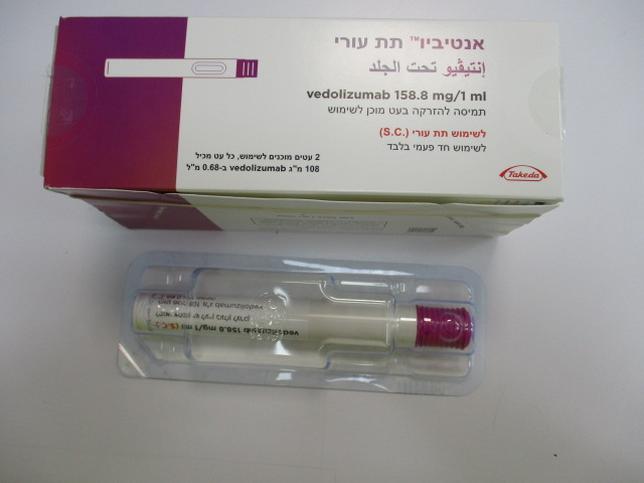Quest for the right Drug

אנטיביו תת עורי ENTYVIO S.C (VEDOLIZUMAB)
תרופה במרשם
תרופה בסל
נרקוטיקה
ציטוטוקסיקה
צורת מתן:
תת-עורי : S.C
צורת מינון:
תמיסה להזרקה : SOLUTION FOR INJECTION
עלון לרופא
מינוניםPosology התוויות
Indications תופעות לוואי
Adverse reactions התוויות נגד
Contraindications אינטראקציות
Interactions מינון יתר
Overdose הריון/הנקה
Pregnancy & Lactation אוכלוסיות מיוחדות
Special populations תכונות פרמקולוגיות
Pharmacological properties מידע רוקחי
Pharmaceutical particulars אזהרת שימוש
Special Warning עלון לרופא
Physicians Leaflet
Adverse reactions : תופעות לוואי
4.8 Undesirable effects Summary of the safety profile The most commonly reported adverse reactions are infections (such as nasopharyngitis, upper respiratory tract infection, bronchitis, influenza and sinusitis), headache, nausea, pyrexia, fatigue, cough, arthralgia. No clinically relevant differences in the overall safety profile and adverse reactions were observed in patients who received subcutaneous vedolizumab compared to the safety profile observed in clinical studies with intravenous vedolizumab with the exception of injection site reactions (with subcutaneous administration). Tabulated list of adverse reactions The following listing of adverse reactions is based on clinical trial and post marketing experience and is displayed by system organ class. Within the system organ classes, adverse reactions are listed under headings of the following frequency categories: very common (≥ 1/10), common (≥ 1/100 to < 1/10), uncommon (≥ 1/1,000 to < 1/100), very rare (< 1/10,000) and not known (cannot be estimated from the available data). Within each frequency grouping, adverse reactions are presented in order of decreasing seriousness. Table 1. Adverse reactions System organ class Frequency Adverse reaction(s) Infections and infestations Very common Nasopharyngitis Common Pneumonia, Clostridium difficile infection, Bronchitis, Gastroenteritis, Upper respiratory tract infection, Influenza, Sinusitis, Pharyngitis, Herpes zoster Uncommon Respiratory tract infection, Vulvovaginal candidiasis, Oral candidiasis Immune system disorders Very rare Anaphylactic reaction, Anaphylactic shock Nervous system disorders Very common Headache Common Paraesthesia Eye disorders Uncommon Blurred vision Vascular disorders Common Hypertension Respiratory, thoracic and Common Oropharyngeal pain, mediastinal disorders Nasal congestion, Cough Not known Interstitial lung disease Gastrointestinal disorders Common Anal Abscess, Anal fissure, Nausea, Dyspepsia, Constipation, Abdominal distension, Flatulence, Haemorrhoids Skin and subcutaneous tissue Common Rash, disorders Pruritus, Eczema, Erythema, Night sweats, Acne Uncommon Folliculitis System organ class Frequency Adverse reaction(s) Musculoskeletal and connective Very common Arthralgia tissue disorders Common Muscle spasms, Back pain, Muscular weakness, Fatigue, Pain in the extremity General disorders and Common Pyrexia, administration site conditions Infusion site reaction (including: Infusion site pain and Infusion site irritation), Infusion related reaction, Injection site reactions# Uncommon Chills, Feeling cold # Subcutaneous administration only. Description of selected adverse reactions Injection site reactions Injection site reactions (including pain, oedema, erythema or pruritus) were reported in 5.1% of patients receiving subcutaneous vedolizumab (pooled safety analysis). None resulted in discontinuation of study treatment or changes to the dosing schedule. The majority of injection site reactions resolved within 1-4 days. There were no reports of anaphylaxis following subcutaneous vedolizumab administration. Infections In GEMINI 1 and 2 controlled studies with intravenous vedolizumab, the rate of infections was 0.85 per patient-year in the vedolizumab-treated patients and 0.70 per patient-year in the placebo-treated patients. The infections consisted primarily of nasopharyngitis, upper respiratory tract infection, sinusitis, and urinary tract infections. Most patients continued on vedolizumab after the infection resolved. In GEMINI 1 and 2 controlled studies with intravenous vedolizumab, the rate of serious infections was 0.07 per patient year in vedolizumab-treated patients and 0.06 per patient year in placebo-treated patients. Over time, there was no significant increase in the rate of serious infections. In controlled and open-label studies in adults with intravenous vedolizumab, serious infections have been reported, which include tuberculosis, sepsis (some fatal), salmonella sepsis, listeria meningitis, and cytomegaloviral colitis. In clinical studies with subcutaneous vedolizumab, the rate of infections was 0.26 per patient year in vedolizumab-treated patients. The most frequent infections were nasopharyngitis, upper respiratory tract infection, bronchitis and influenza. In clinical studies with subcutaneous vedolizumab, the rate of serious infections was 0.02 per patient year in subcutaneous vedolizumab-treated patients. In clinical studies with intravenous and subcutaneous vedolizumab, the rate of infections in vedolizumab-treated patients with BMI of 30 kg/m2 and above was higher than for those with BMI less than 30 kg/m2. In clinical studies with intravenous and subcutaneous vedolizumab, a slightly higher incidence of serious infections was reported in vedolizumab-treated patients who had prior exposure to TNFα antagonist therapy compared to patients who were naïve to previous TNFα antagonist therapy. Malignancy Overall, results from the clinical program to date do not suggest an increased risk for malignancy with vedolizumab treatment; however, the number of malignancies was small and long-term exposure was limited. Long-term safety evaluations are ongoing. Reporting of suspected adverse reactions Reporting suspected adverse reactions after authorisation of the medicinal product is important. It allows continued monitoring of the benefit/risk balance of the medicinal product. Any suspected adverse events should be reported to the Ministry of Health according to the National Regulation by using an online form https://sideeffects.health.gov.il

פרטי מסגרת הכללה בסל
התרופה האמורה תינתן לטיפול במקרים האלה:א. טיפול במחלת קרוהן בדרגת חומרה בינונית עד קשה בחולים שמיצו טיפול קודם – טיפול לא ביולוגי או טיפול ביולוגי. ב. טיפול במחלת מעי דלקתית מסוג Ulcerative colitis בחולים שמיצו טיפול קודם – טיפול לא ביולוגי או טיפול ביולוגי.
מסגרת הכללה בסל
התוויות הכלולות במסגרת הסל
| התוויה | תאריך הכללה | תחום קליני | Class Effect | מצב מחלה |
|---|---|---|---|---|
| טיפול במחלת מעי דלקתית מסוג Ulcerative colitis בחולים שמיצו טיפול קודם | 15/01/2015 | |||
| טיפול במחלת קרוהן בדרגת חומרה בינונית עד קשה בחולים שמיצו טיפול קודם | 15/01/2015 |
שימוש לפי פנקס קופ''ח כללית 1994
לא צוין
תאריך הכללה מקורי בסל
15/01/2015
הגבלות
תרופה מוגבלת לרישום ע'י רופא מומחה או הגבלה אחרת
מידע נוסף
